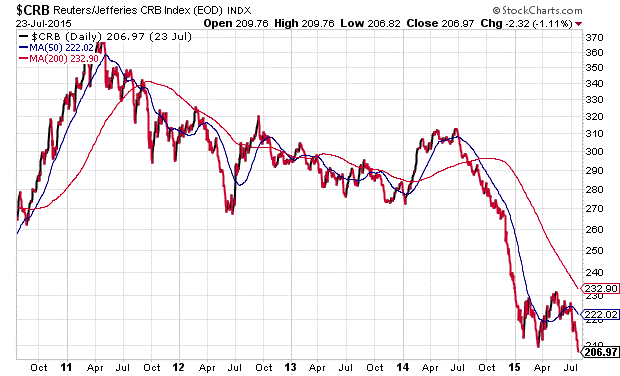In typical herd mentality, investors have decided they love to hate resources.
Commodity prices crashed to a 13-year low in July as commodities became the most hated sector of the market.
Why?
For one, the largest developed economies in the world struggle to generate growth as they try to recover from the seven-year-old financial crisis.
Recent strength in the U.S. dollar, which prices most major commodities, hasn't helped, either.
But the cure for low prices is low prices. And it appears we're nearing the point of maximum pessimism. Opportunity could be just around the corner.
Here's how low commodity prices have affected major producers - plus a look at the factors that will drive prices higher...
Major Commodity Index's Dismal Performance
It's little wonder a vast majority of investors are down on commodities.
Here's what the widely followed Thomson Reuters/Jefferies Commodity Research Bureau (CRB) Index, which tracks 19 commodities from aluminum to wheat, has done over the last five years:
It's not pretty. The index is down about 44% from its peak in early 2011.
But that's not the whole story.
Look at what's been happening to some of the world's biggest diversified commodities producers.
Producers Struggle amid Low Commodity Prices
Anglo American Plc. (LON: AAL) is a $10 billion multinational headquartered in London. It's the world's largest producer of platinum, accounting for about 40% of global output. It's also a major producer of diamonds, copper, nickel, iron ore, and coal.
Anglo recently announced it had lost $3 billion in H1 this year. Profits were down 36% over H1 last year. As a result of the seemingly endless rout in commodity prices, the company plans to cut 53,000 jobs, or 35% of its total workforce, over the next few years.
With the company's shares trading at their lowest in a decade, CEO Mark Cutifani seeks to put as many as 15 company assets up for sale.
These next two companies have been hard hit, too - but several signs point to better days ahead...
BHP Billiton Ltd. (NYSE ADR: BHP) is a $96 billion diversified miner, the largest by market cap. Headquartered in Melbourne, Australia, this resource behemoth is struggling as well. It produces iron ore, diamonds, coal manganese, gold, petroleum, aluminum, copper, natural gas, nickel, uranium, and silver.
BHP recently forecast a pre-tax impairment charge of $2.8 billion this year, after a $20 billion venture into U.S. shale and its 2011 Petrohawk Energy acquisition.
Freeport-McMoRan Inc. (NYSE: FCX) is a $13 billion miner located in Phoenix that explores for and produces copper, gold, molybdenum, cobalt, silver, and other metals, as well as oil and gas. Its Q2 results showed a net loss of $1.85 billion, compared to a gain of $482 million in the same period last year.
FCX shares are down 42% this year on commodity price weakness. Management recently suggested it might sell its Candelaria copper mine in Chile, which has already been on the market for some time, according to The Wall Street Journal.
As a proxy for the sector, here's how the iShares S&P/TSX Global Base Metals ETF (TSE: XBM) has performed. Over the past five years, the exchange-traded fund is down nearly 50%.
But real assets, the kinds these companies produce, have intrinsic value. And there are significant demographic trends at play that will ensure commodity prices reverse course in the future.
Population Growth and Urbanization Will Send Commodity Prices Higher
The world's population is still growing by about 90 million a year. And the countries where most of the population expansion is taking place are in their own economic growth phase.
[epom key="ddec3ef33420ef7c9964a4695c349764" redirect="" sourceid="" imported="false"]
China and India, which represent nearly 30% of the world population, have annual growth rates in the 7% range.
Demand power for China's consumer base could reach $67 trillion over the next decade as the Asian nation transforms to a consumption economy, according to The Demand Institute, a think tank run jointly by The Conference Board and Nielsen.
That's going to take a lot of stuff. And someone's going to have to provide the raw materials to make it.
So as commodity prices languish right now, consider that the next bull run could be just around the corner. It will pay to be ready.
Stay informed on what's going on in the markets by following us on Twitter @moneymorning.
How to Profit from China's Surging Demand Power... China's massive transformation toward a consumer-driven economy means demand for all things consumer-related will keep charging higher. And one U.S. company is the top choice to profit from this shift...




